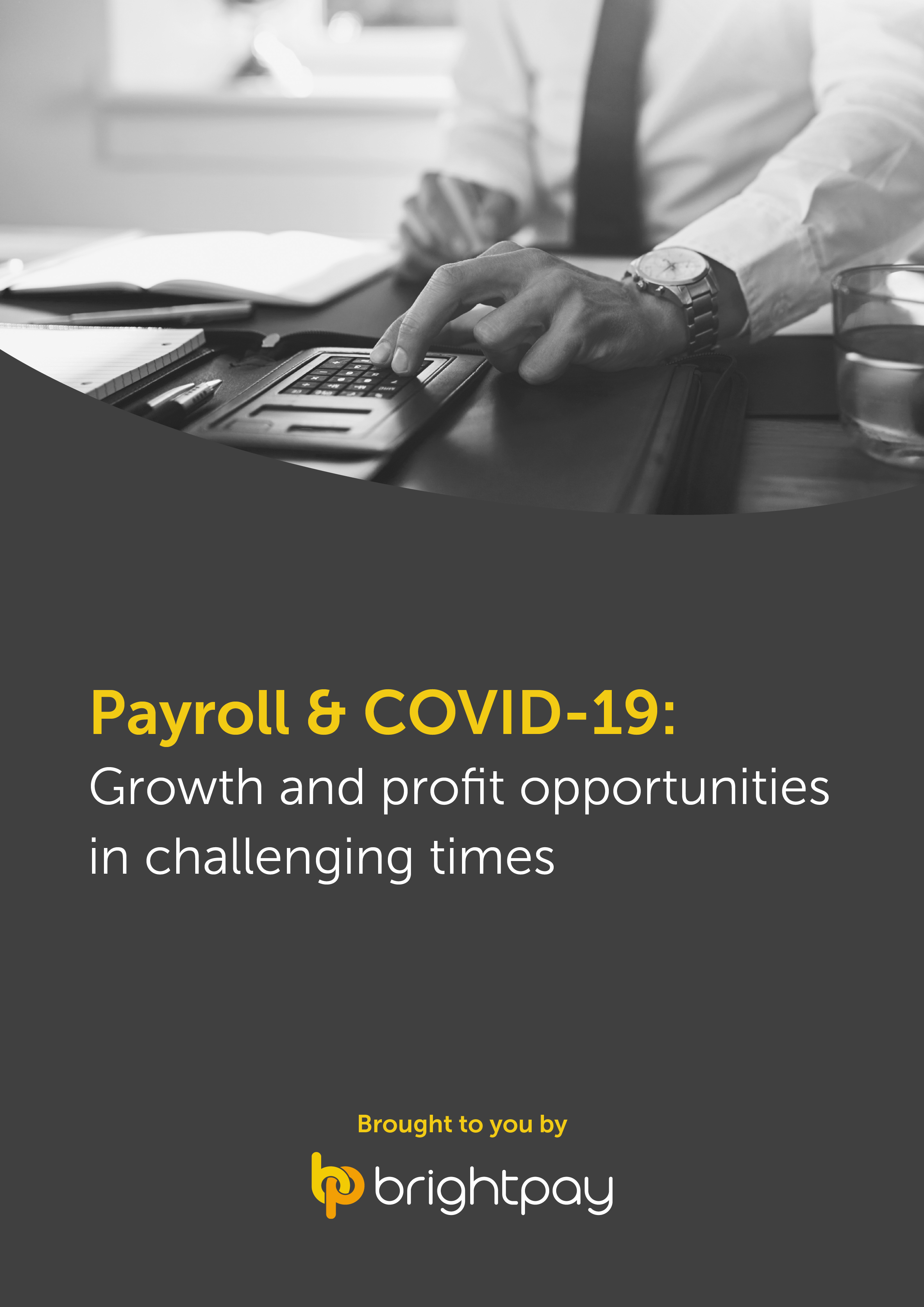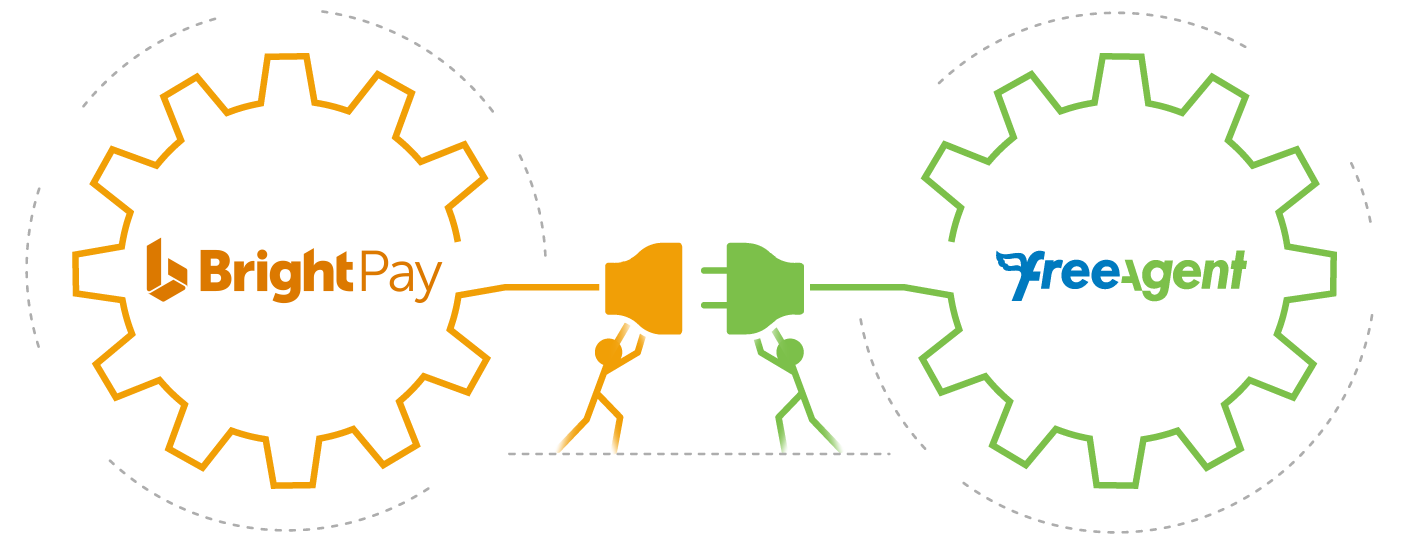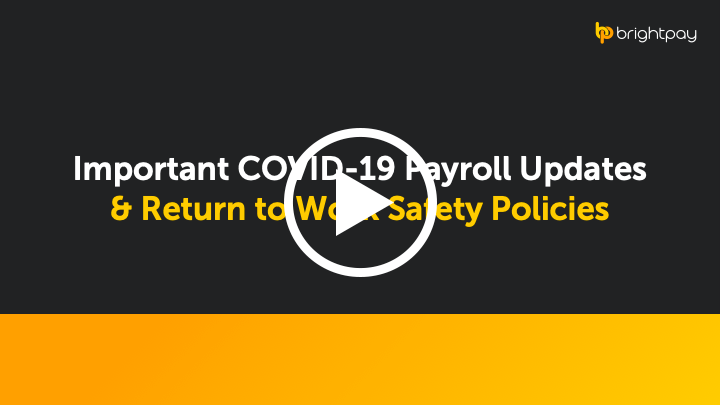Feb 2021
2
Customer Update: February 2021
Welcome to BrightPay's February update. Our most important news this month include:
-
New Proposed Statutory Payment Rates Announced for 2021-22
-
Self Assessment late filing penalty deadline extended to 28th February
-
Free webinar: A recap of recent furlough changes
-
Changes to the Kickstart Scheme
How to spend less time on payroll & furlough
In the past year, the role of the payroll processor has been made even more complex than ever before with furlough calculations and working from home. It’s now more important than ever before to automate payroll tasks. In this free webinar, we look at how integrated payroll and accounting systems can help reduce time wasted on manual work. Places are limited.
Are you ready for the changes to IR35?
From April 2021, the rules in relation to off-payroll workers are due to change for contractors working with medium to large sized clients in the private sector. BrightPay will be able to cater for workers who are inside IR35.
Coming in February: BrightPay Connect supports two-factor authentication sign in
With two-factor authentication, you can add an extra layer of security to the employer login on your BrightPay Connect account in case your password is stolen. Instead of only entering a password to log in, you’ll also enter a code or use a security key.
10 Benefits of using a Cloud Payroll Portal to Manage Employees Annual Leave
COVID-19 has created many new challenges for organisations processing their employees’ annual leave entitlements. As more people are now working remotely, it is likely that organisations’ annual leave request methods are no longer adequate. Discover ten benefits of using BrightPay Connect to manage your staff’s annual leave.
Switching to BrightPay: Free Migration Consultation
Book a demo today to avail of a free migration consultation with the BrightPay team. You will be assigned a dedicated account manager to help you through the setup process, ensuring a smooth transition to BrightPay. Don't delay - migration appointments are filling up fast!
COVID-19 & the big shift to bringing payroll in-house to safeguard jobs
The impact of COVID-19 has seen a growing shift towards businesses bringing their payroll in-house to save money and reduce the risk of employee redundancies. Register for our free webinar to discover the benefits that businesses can gain by making the switch to bringing their payroll in-house.
Jan 2021
12
Customer Update: January 2021
Welcome to BrightPay's January update. Our most important news this month include:
-
3 simple ways to automate your payroll
-
BrightPay: The heroes that were needed for payroll professionals
-
How to manage COVID-19 related statutory sick pay
-
From the support desk: Annual leave entitlement methods in BrightPay
Free Webinar: Optimising your payroll offering to improve profitability
Many accountants would say that offering payroll as a service is not necessarily cost-effective and that it can be a very time-consuming process. But this doesn’t need to be the case. In this webinar, we explore various ways that accountants can automate payroll processes, and ultimately, become more profitable.
Payroll in the Connected Era: How integration has transformed the world of payroll
During this webinar, BrightPay will discuss the benefits of integrating your payroll and accounting software. We will also demonstrate how you can streamline the entire process from start to finish. Discover how you can free up time for you to spend on other tasks that really need your attention.
Why employees love self-service apps (And you should too!)
Today’s employees are accustomed to having information readily available. An employee portal can help fulfil that expectation with the added benefit of creating workflow efficiencies. The employee self-service app eliminates the burden of sending payslips, updating personal information, approving annual leave requests and answering leave balance enquiries for the payroll department.
HMRC announce more furlough changes for 2021
HMRC have set out the detail of how the CJRS will operate from 1st February onwards, including a further extension to 30th April 2021. Join us on 2nd February as we recap upcoming changes to the furlough scheme and what these changes mean for your business. Plus, we will share some of the key lessons learned from processing payroll in a pandemic, and how it prepares us for payroll in the ‘next normal’.
Key payroll changes to keep an eye on in 2021
If 2020 has taught us anything it’s that you never know what’s around the corner. All the plans and predictions we made for this year fell through our fingers with the pandemic and global recession. Here we look at three things that are likely to happen in 2021 which those working in payroll need to keep an eye on. It’s always good to be prepared!
Dec 2020
1
Customer Update: December 2020
Welcome to BrightPay's December update. Our most important news this month include:
-
3 Things In Payroll To Keep An Eye On In 2021
-
Furlough Extension: Full Guidance Published - Here’s a Recap
-
BrightPay’s Response to COVID-19
Important HMRC update: Extended furlough scheme
Still confused about the extended furlough scheme? Don’t worry, you’re not alone. In this webinar, we deep-dive into what you need to know about the extension of the Coronavirus Job Retention Scheme and what it now means for your business.
Is moving to the cloud the best way to manage compliance during COVID-19?
Anyone involved in managing a payroll will acknowledge that compliance is one of their biggest challenges. COVID-19 has made this task even more difficult. The big question was, how do we maintain strict control over payroll data and processes while away from the office? With workforces now dispersed, here’s how BrightPay Connect can help you.
Payroll & COVID-19: Growth and profit opportunities in challenging times
Payroll bureaus are urged to plan and prepare for the upcoming challenges COVID-19 brings to their payroll services. Now is the time to plan and future-proof your payroll bureau for survival. This guide lifts the lid on how to safeguard your payroll services for profit and mitigate against upcoming COVID-19 scheme changes.
COVID-19 and the challenge of pricing your payroll services
GoProposal and BrightPay discuss how to address the challenge that most accountants face, over-servicing and under-charging. We look at how technology will be key to the future profitability of your payroll service (and why clients should expect to pay for it). Learn how new automation turns daunting payroll tasks into smooth and profitable tasks.
Furlough Extension: Full Guidance Published - Here’s a Recap
With the furlough scheme due to end back in October, and a replacement Job Support Scheme due to begin in November (and then promptly being cancelled again) you could be forgiven for being a little confused over the current status of the furlough scheme. Here we look at what the newly extended furlough scheme means for your business.
Streamline Annual Leave Management this Christmas
It’s safe to say that Christmas is going to look very different for all of us this year. But the one thing that will remain the same is employees wanting time off over the holiday period. But don’t worry, we’re here to take the pain out of managing your employee leave this Christmas with BrightPay Connect.
Nov 2020
3
Customer Update: November 2020
Welcome to BrightPay's November update. Our most important news this month include:
-
BrightPay announces API integration with AccountsIQ
-
New coronavirus fines introduced for employers
-
Why are BrightPay the perfect payroll partner during challenging times?
-
Switching payroll software providers? Ask these 10 questions first
The Original Furlough Scheme is back: Who can claim?
The Coronavirus Job Retention Scheme (CJRS) was due to come to an end on 31st October 2020. However, with further COVID-19 restrictions announced, the CJRS has been extended for another month until 30th November 2020. This also means that the introduction of the Job Support Scheme, which was due to start on 1st November 2020, has been postponed until December.
COVID-19 & achieving business continuity in the cloud
In the ‘new normal’, employers and employees expect to access their payroll information in the cloud. Self-service online portals are changing the way businesses interact and communicate with their employees, whilst providing the cloud functionality to get things done smarter and faster. BrightPay Connect enables clients to submit employee hours, approve the payroll run, manage their employees’ leave, run payroll reports and much more.
Safeguard your payroll against COVID-19
In this guide, we look at how you can overcome payroll processing inefficiency in a crisis. Discover top tips to ensure COVID-19 does not slow down your bureau’s payroll processing and how you can respond quickly and effectively to avoid disruption in the future.
Free webinars: HMRC updates, redundancy and safeguarding your payroll
Join our payroll and HR experts in our upcoming webinar as they talk through a range of topics, including the extended CJRS, the Job Support Scheme, HMRC updates, redundancy, API integration with accounting software and safeguarding your payroll against COVID-19. Guest speakers include AccountsIQ & GoProposal. Limited places available.
Reduce payroll overheads to futureproof against the impact of COVID-19
As businesses look at creative ways to save jobs, many are moving to reduce their business overheads. Savvy businesses have already saved thousands by opting for a payroll provider that does not have an additional charge for auto enrolment, CIS or customer support. BrightPay is one of the most competitively priced payroll software on the market with no contract ties. Making simple changes and investing in payroll solutions with integrated cloud access can save money, improve productivity and increase profits.
Oct 2020
26
Solving the recent "blank screen" issue with BrightPay's Quickbooks integration.
BrightPay is built on a technology called WPF, which is part of Microsoft’s very popular .NET Framework. For .NET development on Windows, WPF has been the first-choice framework for over a decade, and is still very much going strong.
From its beginnings, WPF has included the ability to display and interact with web-based content in a special user interface component called WebBrowser. BrightPay uses WebBrowser to display the “log in” web pages that are required for certain API integrations (e.g. when submitting pension contributions or posting payroll journals to certain providers). WebBrowser has worked well, but it has one aspect that is beginning to cause problems.
WebBrowser is based on Microsoft’s Internet Explorer browser, which has an end-of-life support date of 21 August 2021, meaning that from then on it will no longer receive security updates. Apart from that, Internet Explorer lacks support for many modern technologies, and the web development community has been cheering on its deprecation for years.
In September 2020, BrightPay customers started to notice that our integration with QuickBooks (for posting payroll journals) is no longer working – the log in process results in a blank screen. This is happening because Intuit (the creators of Quickbooks) have dropped their support for Internet Explorer – they are now using technology that is simply too modern for Internet Explorer (and therefore BrightPay's use of WebBrowser) to handle. In the coming months and years, one by one, many other cloud-based software providers will no doubt be doing the same.
So where does this leave BrightPay? Well, you might be aware that in 2015, Microsoft released the first version of their successor to Internet Explorer: the Edge browser. It wasn’t until 2019 that a WPF component for using Edge in Windows applications was made available. This component, called WebView, is not perfect, however, and comes with some technological shortcomings that made us decide to not adopt it right away.
Despite the shortcomings with WebView, when Intuit made their announcement that they would not support Internet Explorer anymore, we created a version of BrightPay that uses WebView and began testing it internally. But not long after, Intuit revised their announcement, confirming that they would not be supporting the Edge browser either. This left us in a bit of a quandary.
Earlier this year, Microsoft released a new version of Edge, based on the same technology that powers the Google Chrome browser. Although it has the same name as the Edge browser from 2015, it is completely different (and Intuit have confirmed that the new Edge will be supported by Quickbooks). Microsoft have also since announced that they will be releasing a component to allow WPF applications to use the new Edge browser, called WebView2, in Q4 2020. This is a much better component than WebView, with wider support, less restrictions and improved deployment. It’s the obvious solution to our Quickbooks problem, except that at the time of writing this, it has still not been released. But it will be soon.
And so, our only real choice is to wait until the WebView2 component is available. As soon as it is, we will prioritise its integration. When that's done, BrightPay customers who need to post journals to Quickbooks should no longer have any issues.
In the meantime, BrightPay version 20.6 contains the WebView component (based on the legacy Edge browser), as we have found that despite Intuit’s claim to not support legacy Edge, it seems to still work for posting journals to Quickbooks anyway. Hopefully, it will continue to do so until WebView2 is available.
Please note that to use WebView in BrightPay 20.6, you (i) must have Windows 10 version 1803 or higher and (ii) you must not run BrightPay in administrator mode. Otherwise, BrightPay will fall back to using the Internet Explorer-based WebBrowser, and the Quickbooks integration will not work. Also, to be able to support WebView (and in preparation for supporting WebView2), BrightPay now requires the .NET Framework version 4.7.2 or higher. If your computer does not already have this version, you will need to download and install it manually to be able to continue using BrightPay.
NOTE: BrightPay for Mac users are not affected by any of this.
UPDATE (January 2021): WebView2 was released in November 2021, and we were able to integrate it into BrightPay and complete a successful pilot test run with some of our customers. I'm pleased to confirm that BrightPay 20.8 (now available for everybody) contains WebView2, and so should put an end to browser incompatibility problems for once and for all.
Oct 2020
1
Customer Update: October 2020
Welcome to BrightPay's October update. Our most important news this month include:
-
HMRC set to crack down on furlough fraud
-
Free eBook: How to Price BrightPay Connect for your Payroll Clients
-
Kickstart Scheme opens for employer applications
-
Managing Annual Leave During COVID-19: 3 Tips Every HR Manager Needs To Know
CJRS is ending! What's in store for the months ahead?
Note: the new Job Support Scheme that was due to commence on 1 November 2020. However, the start of a second England-wide lockdown has prompted the Government to extend the existing furlough scheme until December – pushing back the start date for the Job Support Scheme
What’s in store for employers over the coming months as the Coronavirus Job Retention Scheme ends? Join us for a free webinar where we examine key concerns:
- What is the NEW Job Support Scheme?
- Can you avail of the Job Retention Bonus?
- What are the rules in relation to redundancies?
- Will remote working remain beyond 2020?
BrightPay’s Customer Satisfaction Survey – The results are in!
At BrightPay, we take customer satisfaction very seriously. We regularly carry out customer surveys to make sure our customers are satisfied with their BrightPay experience. These surveys provide invaluable information regarding what our customers want and need, and what we need to work on moving forward. We’ve compiled the results of our latest survey and we wanted to share them with you.
Furlough Changes for October
In October, the government will pay 60% of wages up to a cap of £1,875 for the hours the employee does not work. Employers will need to pay employer NI contributions and employer pension contributions plus 20% of wages to make up 80% of the total, up to a cap of £2,500. After 31st October, the government contributions will finish, and the scheme will come to an end. The new Job Support Scheme will start in November to top up the wages of employees unable to work full-time because of coronavirus restrictions over the winter.
What’s not to LOVE about BrightPay’s integration with FreeAgent
Together with FreeAgent, we’ve built a meaningful API integration to make payroll refreshingly easy while keeping your accounting simple. BrightPay produces the payroll journal in a file format that is unique to FreeAgent. Users can easily upload their payroll figures into their general ledger from within BrightPay using the FreeAgent API facility.
Redundancy and Notice Pay for Furloughed Employees
With the end of the Coronavirus Job Retention Scheme fast approaching, more employers are having to consider the issue of redundancies. New regulations which came into effect on 31 July 2020 have changed the way in which statutory redundancy and notice pay must be calculated in respect of employees who have been furloughed. If a worker loses their job and is entitled to redundancy pay, this should be calculated based on their pre-furlough wages. Firms cannot use the money from furlough to subsidise redundancy packages.
Sep 2020
1
Customer Update: September 2020
Welcome to BrightPay's September update. Our most important news this month include:
-
Furlough wind down timescales
-
Do SEISS grants need to be paid back?
-
Thresholds to rise for Student Loan repayment from 6th April 2021
Furlough Changes for September
The Coronavirus Job Retention Scheme is ending fully on 31st October 2020, but until then, the level of the grant will be reduced each month. For September, the government will pay 70% of wages up to a cap of £2,187.50 for the hours the employee does not work. Employers will need to pay employer National Insurance contributions and employer pension contributions plus 10% of wages to make up 80% of the total, up to a cap of £2,500.
Free Webinar: CJRS & Flexible Furlough - Changes you need to know
As the government’s furlough scheme winds down in upcoming months, employers will need to contribute to employees’ wages and the Coronavirus Job Retention Scheme will end fully at the end of October 2020. In this webinar, we look at what you need to know about reduced government contributions, flexible furlough and making a claim.
Benefits of employee apps that you never knew (and why employees love them)
BrightPay Connect offers a whole host of additional features, from automatic cloud backup to employee dashboards. However, the employee app is one of the most attractive of these additional features, and for good reason. It enables you to introduce more effective ways of communicating with employees and streamline everyday processes such as annual leave requests.
Easily integrate BrightPay with your accounting software
BrightPay’s payroll journal feature allows users to create wage journals from finalised pay periods so that they can be seamlessly transferred into various accounting packages. BrightPay includes direct API integration with a number of accounting packages. With this direct integration, users will be able to directly send the payroll journal to the accounting package from within BrightPay.
Aug 2020
7
Customer Update: August 2020
Welcome to BrightPay's August update. Our most important news this month include:
-
Chancellor announces furlough bonus scheme and more in Summer Statement
-
CJRS Changes & Flexible Furlough - What you need to know
-
Flexible Furlough - Calculating Employee Hours
BrightPay Connect - What’s New?
This month saw a number of updates to BrightPay Connect, including a new option to download all payslips in a given period. The calendar functionality in BrightPay Connect has also been updated and improved, making it more user-friendly and graphically appealing for both employers and employees. Improvements such as calendar and leave view, custom leave types and requesting leave are part of the new enhancements.
Free COVID-19 & Payroll Webinar
Join BrightPay on 12th August for a free COVID-19 & Payroll webinar. In this webinar, we explore the key changes in relation to flexible furlough, phasing out of the scheme and changes to making a claim. This new flexibility will help businesses with reopening and help boost the economy. Places are limited. Click here to book your place now.
Processing Employee Hours Made Simple With BrightPay Connect
We’re always keen to hear what the biggest challenges are for payroll bureaus and how we can help make their job easier. One of the most common issues we understand is that requesting payroll information from clients can be an inefficient, time-consuming and often, frustrating process. The good news is that BrightPay Connect makes this process so much simpler. It has become a must-have tool for bureaus who want to streamline their payroll process and increase efficiency.
Automate Annual Leave Management with BrightPay Connect
After months of lockdown, many people are embracing the idea of staycations in a bid to save what’s left of the summer. For employers, however, managing employee leave can be far from relaxing if it is a manual process. BrightPay Connect’s online leave management tools eliminate cumbersome people management tasks. It’s more than just payroll software, it’s a ready-to-go, easy-to-use HR software solution. The staycation trend should be a reason to be excited, not an admin nightmare.
Jul 2020
2
Customer Update: July 2020
Welcome to BrightPay's July update. Our most important news this month include:
-
Timeline - Furlough scheme to wind-down gradually
-
Flexible Furlough - Employees Returning to Work Part-Time
-
Chancellor to grant “draconian” powers to reclaim millions in Covid-19 support payments
-
Calculating a flexibly furloughed employee's 'usual hours'
Changes to the CJRS & Furloughing Employees
The Coronavirus Job Retention Scheme has been hugely popular and will continue to support jobs until the end of October. However, from 1st July, there will be many changes to the scheme. Here we've put together a summary of some of the key points in relation to flexible furlough, phasing out of the scheme and changes to making a claim.
Employees returning from statutory leave after 10 June 2020
From 1st July 2020, employers will only be able to claim for employees who have previously been furloughed for at least 3 consecutive weeks any time between 1st March 2020 and 30th June 2020. An exception to this is where an employee is returning from statutory parental leave after 10th June 2020 and meets the qualifying criteria to be furloughed for the first time.
CJRS calculations have changed in BrightPay from version 20.5 onwards
For many of our customers, this calculation change will not make a difference. But those who pay in lieu (e.g. a July pay date for June payroll), or those for whom an already submitted claim period ending 30 June did not actually cover all of June's earnings, will need to check and ensure that all reclaimable amounts are accounted for and submitted to HMRC prior to making July claims.
COVID-19 Webinar - Did you miss it? Watch on-demand now
During our most recent webinar, we looked at upcoming changes to the Coronavirus Job Retention Scheme. We also examined five principles that employers should be following to protect employees as they come back to work. Don't miss out - watch it back anytime.
May 2020
27
Customer Update: June 2020
Welcome to BrightPay's June update. Our most important news this month include:
-
Unemployment set to skyrocket despite the Coronavirus Job Retention Scheme
-
Furlough scheme extended until October
-
Claim Guidance for Coronavirus Statutory Sick Pay Claim
-
Self-employment income support scheme is rolled out
Free Webinar: Important COVID-19 Payroll Updates & Return to Work Safety Policies
The government has announced the first steps to ease the coronavirus restrictions with a roadmap in place for lockdown measures to be slowly lifted. Understand how to adapt your payroll processes to accommodate for the schemes and subsequent updates.
Claim Guidance for Coronavirus Statutory Sick Pay Claim
Employers will need to make a claim for any COVID-19 related SSP they wish to reclaim through HMRC's Coronavirus SSP Rebate Scheme online service. This online service is now available to use and can be accessed here. A Claim Report is available in BrightPay to assist users in ascertaining the amounts needed for input into HMRC's Coronavirus SSP Rebate Scheme online service.
Furlough Scheme available until 31st of October
Chancellor Rishi Sunak has advised the Coronavirus Job Retention Scheme will be available for employers for furloughed employees until the end of October 2020 and will introduce a new flexibility option under the scheme from August. This will apply to all regions and sectors in the UK economy.
Return to Work Safety Policies
With the emergence from lockdown becoming clearer, businesses will need to start to put plans and COVID-19 policies in place for their employees to go back to the workplace safely. It is advisable for all workplaces to adapt their workplace HR policies, procedures and practices to comply with the COVID-19 related safety guidelines.
Coronavirus Job Retention Scheme - Claim Report in BrightPay
BrightPay includes a new CJRS Claim Report. This report can be used to ascertain the amounts needed for input into HMRC's online service, including the gross furlough amount, employer National Insurance contributions, employer minimum pension contributions and total claim amount. For employers with over 100 employees, you also have the option to export the report to a CSV file, ready for import into HMRC's portal.














